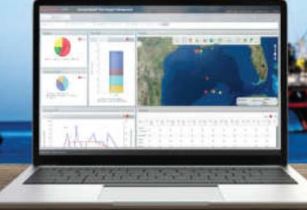Halliburton Landmark discussed how its DecisionSpace® Well Integrity Management software can help minimise risks and reduce production losses
Today, there is an increased number of producing fields that exhibit late life symptoms such as ageing well stocks, high water cut, and flow assurance issues. These symptoms can lead to well integrity issues such as high casing pressure, mechanical failures, or corrosion problems. Many gas fields report high CO2 and H2S content, which can pose challenges for pipe metallurgy and reliability. Faced with more stringent regulations, a shrinking experienced workforce, and the need to control costs, E&P operators’ focus on Well Integrity Management (WIM) has increased.
The post-2014 price collapse strengthened WIM, when E&P companies started to look for cost-effective ways to improve recovery from existing fields. Wells that were shut in or impaired due to well integrity issues became obvious opportunities for production gain. These issues also drew attention to the need for better processes and systems to improve well integrity performance.
The past few years have seen an accelerating adoption of digital WIM systems by E&P companies that want to standardise their WIM processes, automate workflows, and drive better risk management.
DecisionSpace® Well Integrity Management software helps minimise risks and associated production losses by streamlining well integrity monitoring and analysis. With automated and integrated workflows, it delivers rapid diagnosis of well barrier elements to spot well integrity risks faster and execute preventive and corrective maintenance. End users can rapidly identify high-risk wells, take corrective actions faster, and mitigate issues to maximise well availability.
Best-in-class engineering
The traditional practice of using standard operating envelope calculations (e.g., Maximum Allowable Annular Surface Pressure or MAASP) does not always fully address complex and intertwined well integrity risk factors such as well head movement, temperature and pressure effects, casing wear, zonal isolation, and tubing/casing safety factor (SPE 164230. March 2013). There are additional elements to consider in managing the integrity of complex wells such as high-pressure-high-temperature, high H2S, or deep-water wells.
Integration with WELLCAT™, a DecisionSpace® software, gives Well Integrity Management software superior ability to detect downhole integrity risks early to help prevent downtime or environmental hazards. Over 80% of operators globally trust WELLCAT for its advanced engineering calculations required for well design
Workflows in Well Integrity Management software automatically obtain engineering calculations to continuously update the Stress and Load envelopes of the tubulars and alert end users if actual operating conditions trend closer to those envelopes. This approach gives end users a better understanding of how changing operating conditions impact the integrity of the wells, which is not always possible with the simple MAASP-based operating envelopes.
Flexibility for customisation
No two oilfields are the same, and neither are their requirements for well integrity management. When a software cannot easily adapt to the unique context of an oilfield operation, it can force E&P companies to operate within the constraints of the software, resulting in lost opportunity for innovation and buy-in from the users.
Well Integrity Management software is built on the fully open, interoperable DecisionSpace platform which offers the flexibility for customisation and the ability to create well integrity management solutions tailored to unique business processes and IT environment.
Future readiness
Any WIM software needs to work in a heterogenous technology environment. It needs to talk with a multitude of data sources and adjust to changing modes of operations or expansion. An inability to adjust to these changing scenarios adds to architectural complexity and cost of ownership, forcing E&P companies to procure additional technologies to keep up with the growing needs of their business.
The underlying DecisionSpace platform connects Well Integrity Management with a variety of data sources and accommodates evolving workflows, visualisation, and analytical needs without requiring additional technologies. DecisionSpace is the foundation for all Halliburton’s digital offerings, and is supported by long-term product roadmaps and R&D investments. With a track record of successful implementations globally, it brings the assurance of referenceable quality and future readiness.
The combination of best-in-class engineering, flexibility for customisation, and future readiness makes Well Integrity Management a unique value proposition for E&P companies looking for a robust, scalable and future proof well integrity management solution.
Discover how DecisionSpace Well Integrity Management software can minimise risks and reduce production losses – email us at
For more information, please visit www.landmark.solutions





